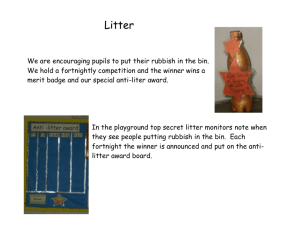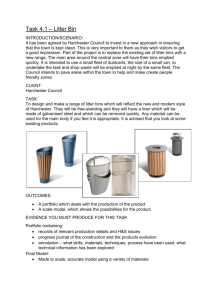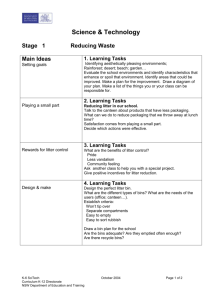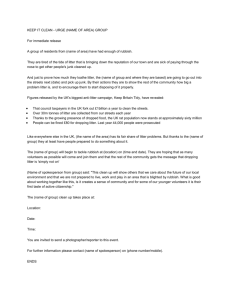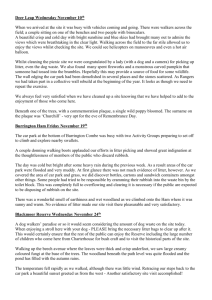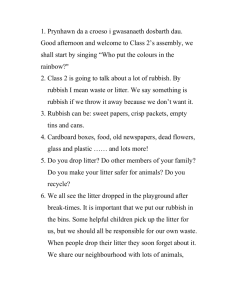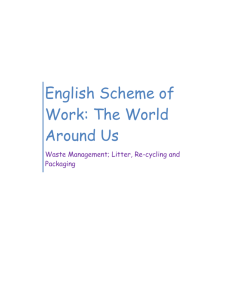Six Simple Steps to Starting Sustainability
advertisement
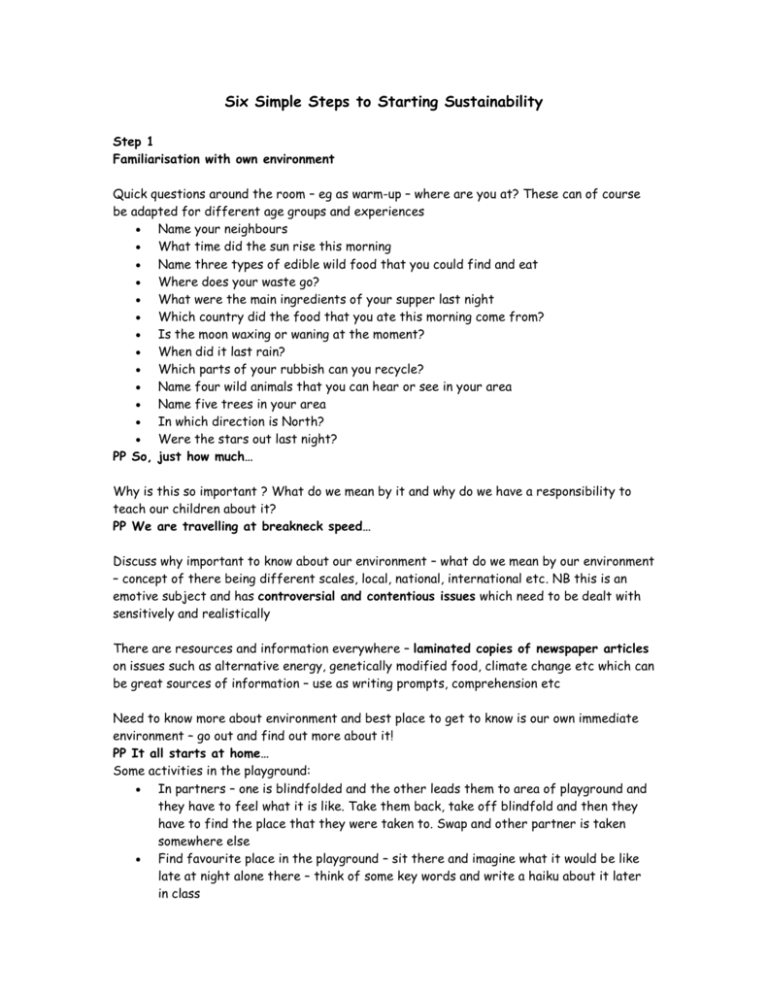
Six Simple Steps to Starting Sustainability Step 1 Familiarisation with own environment Quick questions around the room – eg as warm-up – where are you at? These can of course be adapted for different age groups and experiences Name your neighbours What time did the sun rise this morning Name three types of edible wild food that you could find and eat Where does your waste go? What were the main ingredients of your supper last night Which country did the food that you ate this morning come from? Is the moon waxing or waning at the moment? When did it last rain? Which parts of your rubbish can you recycle? Name four wild animals that you can hear or see in your area Name five trees in your area In which direction is North? Were the stars out last night? PP So, just how much… Why is this so important ? What do we mean by it and why do we have a responsibility to teach our children about it? PP We are travelling at breakneck speed… Discuss why important to know about our environment – what do we mean by our environment – concept of there being different scales, local, national, international etc. NB this is an emotive subject and has controversial and contentious issues which need to be dealt with sensitively and realistically There are resources and information everywhere – laminated copies of newspaper articles on issues such as alternative energy, genetically modified food, climate change etc which can be great sources of information – use as writing prompts, comprehension etc Need to know more about environment and best place to get to know is our own immediate environment – go out and find out more about it! PP It all starts at home… Some activities in the playground: In partners – one is blindfolded and the other leads them to area of playground and they have to feel what it is like. Take them back, take off blindfold and then they have to find the place that they were taken to. Swap and other partner is taken somewhere else Find favourite place in the playground – sit there and imagine what it would be like late at night alone there – think of some key words and write a haiku about it later in class Draw sound maps in different places in the playground, where are the quiet areas, why, are they always the same, what changes etc Using any materials – look at different colours in playground and rub them onto pallet – back in class can do a drawing of playground and try to replicate colours as closely as possible – “Nature’s Pallet” Collect different materials, put into a cup with some water and make a “smelly cocktail” – give it a name and share it around! These all have lots of follow-up activities and can be used as prompts and stimuli for numerous other multi-disciplinary activities. Use the internet to find out more; Google Earth (http://earth.google.com/) , Multi-map (http://www.multimap.com/) , Live Local (http://local.live.com/) etc Step 2 Living Sustainably Discuss how sustainable we are at school. Children could carry out an energy audit and draw up graphs and interpret the results. Look at Carbon Trust for ideas www.carbontrust.co.uk/energy Come up with suggestions about how to improve the school’s energy use and also how to make school more sustainable, recycling more, composting, generating own power through solar panels, wind turbines etc and consider pros and cons of these. As an off-shoot and using DT, could design an environmentally friendly school – using either 2-D or 3-D model plans. There are excellent WWF guidelines on sustainable schools – follow the link, Pathways to Change - www.wwflearning.org.uk/wwflearning-home/pathwaystochange Look for information in the DfES Sustainable Schools documentation and order publications free: Teachernet – Sustainable Schools www.teachernet.gov.uk/sustainableschools Order a free copy: www.teachernet.gov.uk/publications This is becoming increasingly important with the new SEF (s3, the new Sustainable School Self-evaluation) Further example of a whole school audit – “School Sustainable Development audit” PP Step 2a - Living Sustainably at School Consider how sustainably we live at home and in our immediate environment – “How Sustainable?” can be looked at and discussed – will need some adapting for younger children to make wording more comprehensible Children could complete the “Environmental Quality Assessment Survey” and “Pollution in Your Environment” as a homework assignment and draw up results at school and give presentation of their findings to the rest of the class. (More on issues around waste in later section) Other assignments could include “Climate Change 1 & 2” and comparing scores in school the following day. They could consider how they might improve their local environment and make plans for a more sustainable local area – these could form a part of a presentation and be shown to parents, local councillors etc. Step 2b - Living Sustainably at Home Children can calculate their own global footprint – what impact they make on the environment and how they can reduce this. A really good web-site to use with this is: www.globalfootprints.org on which they can work out their global footprint by filling in an on-line questionnaire – there are also lots of games and activities that they can do and find out more about the numerous related issues. On the web-site, direct them to the kids section and the global footprint web-site is in the quizzes section. There are also good classroom activities suggested linked to literacy, numeracy and other disciplines. There is also the facility for calculating the school’s global footprint If you do not have access to the internet for all the children to do their own global footprint – they could do a paper copy, similar to: “Measuring Your Ecological Footprint” which has some interesting statistics at the bottom. Discuss the implications of their footprint and ways in which it could be reduced, what kind of commitment they need to make. Step 2c - Calculating carbon footprints Step 3 A sustainable world? Use any available comparative statistics that you can find to illustrate how much of the environment we are changing every day, how much waste we produce on a global basis etc. eg for each typical UK resident, we would need 2.7 planets… (from Best Foot Forward website: www.bestfootforward.com A really useful one is the apple representing the earth – really visual and effective: Take an apple and slice it into ¼’s. remove ¾ and put aside – that is the oceans of the world Slice remaining ¼ in half and set aside one half aside – that is inhospitable polar areas deserts, swamps, very high or rocky mountains You are now left with 1/8 of the original apple – this is where people live but do not necessarily grow the food that they need for life Slice 1/8 into 4 – set aside 3 of them which are too rocky, too wet, too cold, too steep or with too poor soils to actually produce food – it’s also urban sprawl, cities, roads, highways, car parks etc What we are left with is now 1/32 of the original or about 3% Finally peel the remaining slice – the skin represents the surface of the earth of all that remains to produce food. As discussed, use again the laminated copies of newspaper articles related to issues of sustainability and other environmental issues, giving impression of heightened awareness of subject and the need to promote interest. Brainstorm what the major environmental issues are and what we are doing to make them worse and what we could do to make them better: Include the “hotspots”: Transport, energy, water availability, climate change, food and resources PPStep 3: A sustainable world? Could create information poster or spider diagram with world at centre and all the issues attacking it and use this as part of a display. Is our climate in chaos – are we living sustainably or not? This can open up a lively debate and the children will want to contribute their bit. A good starting point and springboard for such debate is David Attenborough’s excellent programmes on Climate Change and in particular here, the initial one: Are We Changing Planet Earth which are available from the BBC and internet as well as the seminal work by Al Gore, An Inconvenient Truth PPStep 3 (cntd) Lesson 4: Energy Consider what we mean by energy – brainstorm where and when we use energy and why it is so crucial in every aspect of our lives. Where does it come from? Get the children to run in the playground and then walk, when do they feel more tired, why? Think about the fast pace of our lives and how much energy we demand on a daily basis. Try to make a rough estimate of how much we use and what it’s used for. Consider the fact that without energy as we have it today, life would rapidly grind to a halt. Look at the problems of the situation that is created by this. PPStep 4 - Energy Get the children to be creative in coming forward with ideas as to how we could change this, what other methods of energy we could use. Some really useful ideas, resources, links games and activities in the Learning and Teaching Scotland website http://www.ltscotland.org.uk/climatechange/ In DT they could make different models and ascertain which would work most effectively and efficiently – small windmills, solar ovens, small dams etc. Use the ideas from “Making a Solar Oven” Look at WWF publicity material on sustainable schools in their Pathways to Change links and ideas for the future. Consideration of sustainability of transport as it exists today – look into major forms of transport – understand that by far the majority run on fossil fuels and that this can’t continue indefinitely. Brainstorm ideas about how to change and adapt in the future – look into alternatives and come up with design for vehicle for the future – how is it powered, how does it work, what are the design features that make it efficient and sustainable? PPStep 4b – Alternative Energy Step 5: Water and Food Water conservation – how it can most effectively be done – could invite speaker in from local water board, to talk about the problems of water conservation and provision in UK not being just about less rainfall but also about diversion of rivers for use in industries and tired, old pipes that are no longer able to contain the demand put upon them. Consider carefully how much water we use and how much we actually need – there is a big discrepancy between the two which shows up effectively: “Your Entitlement is ..” – it will make them, and you!, think! PPStep 5a: Water and Food Consider the numerous problems with adequate food for all – go back to the apple idea and re-visit the implications for millions of people in the world, where do they get their food etc. Food miles – get children to bring in labels from food that they have eaten during the week – look up in atlas where they come from and estimate the number of miles their food for a week has travelled. Can do some effective graphs to show this using excel programme in upper KS2. Lower down the school can use more simplified bar graphs, which would be equally effective. Discuss the issues and implications of food travelling all this way Another effective way of showing the information is to have a large world map displayed and stick the food labels all around it with arrows showing where the food comes from – this can then be shared with the rest of the school. If there’s space, you could put their graphs around the map as well. PPStep 5b: Water and Food Step 6: What a waste Consider what happens to all our waste – find out how the children feel about their neighbourhood, is it littered, is it kept clean – who keeps it clean, how responsible are we for keeping it clean – do they feel proud of it. How can we improve it? Brainstorm their perceptions of the environment – what do they think of it. Could do a litter survey “Litter Survey” – divide local area into sections and children do tally of type and amount of litter – take digital cameras and get evidence of litter, graffiti etc. Are there enough litter bins, what do people in the local environment think of it – do a questionnaire to ascertain the local view – “Litter Questionnaire” The children can display results of surveys and questionnaires in form of simple bargraphs and then interpret the results, annotate the photos and show where the rubbish is – is there any relationship between the incidence of rubbish and the lack of provision of bins? PPStep 6: What a Waste… What can and should be done about it – could think about improving the environment – use maps and annotate them to show where more bins should be put, possibility of persuading local authority to put recycling centre somewhere in vicinity – if there is a lot of graffiti, could they provide a wall that artists would be allowed, even encouraged to display their work on and so make it less unsightly and negative. They can put all their findings and suggestions together to make an excellent display for the rest of the school and even send some of the information on to the local authority as suggestions for improvement – perhaps some of the children could go to the LA as representatives to put their ideas across, or someone could come in to see the display and take the ideas back. What do we do with our rubbish are we sure it’s all rubbish? “Are you sure it’s waste?” – what makes up our rubbish? For a week or so, keep bins without chucking out contents and then have a look through it. Does it all have to be thrown away – where does it go. Classify it according to where it might go – think about RECYCLING, REUSING, REDUCING. Make sure that they take the message home about thinking about where their rubbish goes and that they shouldn’t throw everything into the central bin but that they should try to do the 3R’s as much as possible. They could even make their own compost bin at school and watch what happens! “Supermarket Science” Make the pledge to go as green as possible – go through the “Living Green” and try to get them and families to commit to as much of it as possible and feed back in near future as to how they have got on. Allow them to feel that they can play a part. A trip to the local municipal centre is really illuminating and powerfully gets across the message that we are creating far too much waste and that it is not sustainable. If possible, try to organise a speaker from the local authority to come in as well to talk to the children about options and what they can do to improve the local environment. PPStep 6b The 3 R’s What next? Some ideas for resources and ideas: PP Resources and ideas – Articles and Links PP Resources and ideas - CPD
